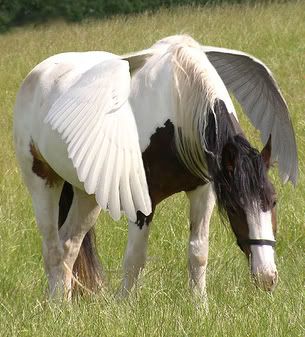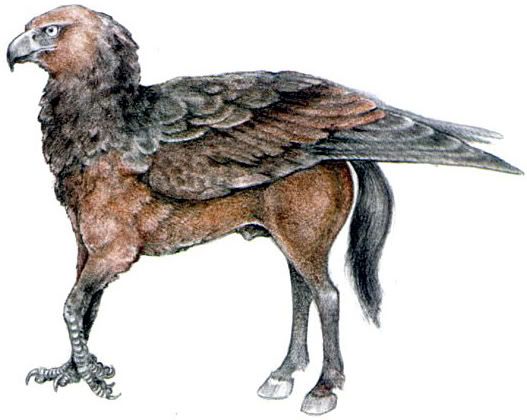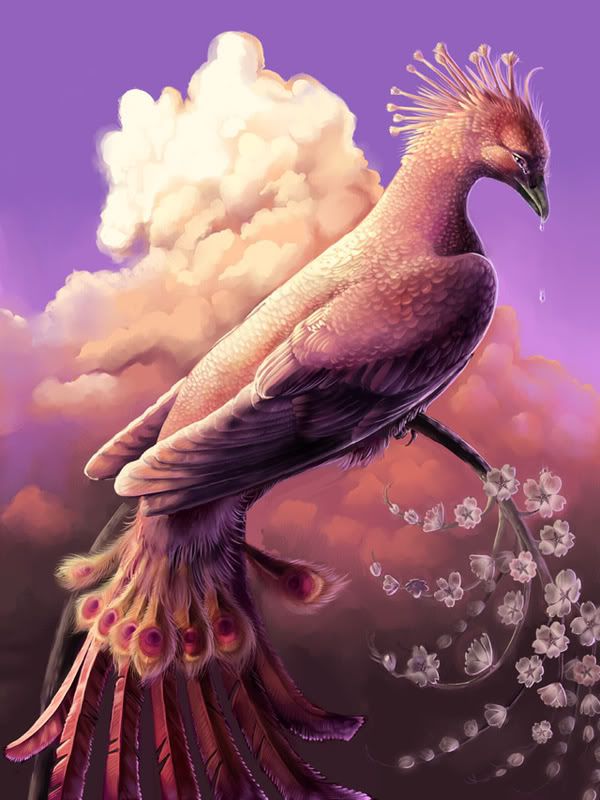|
|
Post by engelbert on Jan 15, 2008 14:22:46 GMT
In this thread you will find a list of all the various creatures and inhabitants of the Western land mass.
|
|
|
|
Post by engelbert on Jan 15, 2008 14:45:10 GMT
The Unicorns
Unicorns are a rare breed of equine that flourishes upon the plainland of Archidet. They are found living in small herds both upon The Beauty and on The Rolling Father.
From afar they seem to be ordinary horses. Their build is muscular yet delicate and they stand at roughly 16 hands (The height of a thoroughbred horse).
Upon closer inspection, unicorns look like a cross between a thoroughbred horse and an arabian. They have dish-shaped faces with a broad forehead and small muzzle. Their tails are carried high and they possess of strong body confirmation with powerful legs and a compact barrel chest. Upon their forehead, central but a couple of inches above eye-level, is a single horn. Males of the species can be distinguished by a billygoat's beard growing. this does not seem to appear until the male reaches adulthood though. All Unicorns have cloven hooves.
Young unicorns are not born with a horn, it starts off as a small, rounded stub of bone where the horn will gradually grow over time. The stub grows with the unicorn until adulthood where it stops growing at roughly 20cm in length. The horn itself is pearlescent in colour. It is cone-shaped, being wider at the base and spiraling up to a sharp point. It is well documented that, if cornered, unicorns will use their horns as a weapon to scare off attackers.
Unicorns do not vary in colour greatly. The most common colour is white, but they may also come in a pale palomino colour or pale grey. This may seem odd as they would stand out greatly on the open plains, but there is an explanation for this colouration. Unicorns are incredibly fast; much faster than a regular horse. Because of this, it is very difficult to get close enough to them to capture them unless they're injured. Even if injured, it is not advised to approach as herds are very protective of their members.
Unicorn herds consist of roughly 20 - 25 members. This number is made up of 3 or 4 leading stallions and a collection of mares, yearlings (young equines over 1 year of age) and new foals. There is usually a lead mare within the herd that leads the way to fresh feeding grounds or safe places to spend the night. It is the job of the stallions to protect the herd and fight off any threats if they are unable to run from danger.
No unicorns are born with wings. The only equine on Archidet that has wings is the pegasi. Nor are unicorns magical, though their horns and tailhair are said to have magical properties that can aid in healing and add power to spells.
Some captured unicorns have been crossbred with ordinary horses but to no avail. Most are stillborn and those that do survive do not live for very long. Examinations on dead unicorn-horse crossbreeds have shown that in foals that survive birth, the horn does not develop correctly and grows inwardly as well as outwardly. This bizarre growth leads to dangerous amounts of brain damage and ultimately death. It is unknown why this occurs but no unicorn cross has ever been known to live beyond it's 6th month. Because unicorns and horses rarely meet in the wild, no known cases of natural crossbreeding are known.
|
|
|
|
Post by engelbert on Jan 15, 2008 15:09:16 GMT
The PegasiThe Pegasi, (or Pegasus in singular terms) is another rare equine that Archidet has to offer. These animals are much less timid than unicorns, and their curiousity will often cause them to investigate campsites or follow travellers who roam within their terratory. Pegasi live in herds similar in size to unicorns, though there are fewer stallions in the herd. Stallions of the Pegasi spend most of their life as drifters and do not readily connect with herds though they are welcomed by mares. This lack of male defence matters little as the pegasi have very few natural predators and so have no need for protective males. The Pegasi stand around 15 hands. They are built similar to akhel-teke horses; strong but fine limbs and a slim body and ribecage. This fine body structure allows them to fly easier as they are incredibly light. Their wings are very large and are similar to those of a swan in all ways except size. A Pegasi's wingspan stretches twice the length of the horse's body from the nose to the base of the tail. The colour of Pegasi is as varied as the common horse. They come in either solid colour (bays, black, white, grey, palomino, chestnut, grulla) or patterns (roan, paint, dappled, appaloosa patterns). Their wing feathers are always the same colour of at least one shade of the Pegasi's coat. Unlike unicorns, pegasi do not have a horn. Though Pegasi are easy to capture, they are not particularly useful either as mounts or for agriculture. Their lithe frames make them too delicate to be ridden without injuring them and the same reason makes them useless as working horses. Occasionally some Pegasi are tamed for use as pets by rich Barons. Their friendly temperment makes them excellent companions for children and regular clipping of their major wing feathers stops them from flying back to their home terratory. Attempts have been made to crossbreed pegasi with ordinary horses but all have failed. Foals either are stillborn or are too weak at birth to survive. Because of their ability to fly, Pegasi have taken to living in steep mountainous terrain. This provides safety from predators and shelter can often be found in caves and caverns. During the day Pegasi can roam quite far and often cover miles in search of fresh fruits or sweet grasses. Pegasi mares only give birth to one foal at a time. This is due to their wings that must be accomodated for in the womb. Pegasi are born with general wing structure but without feathers. Young Pegasi foals quickly develop feathers and are able to fly within 2 weeks. During this development stage, Pegasi mares rarely stray from their mountainous homes for long periods of time. When they need to feed, the foal is left with another mare for safety. 
|
|
|
|
Post by engelbert on Jan 15, 2008 20:53:02 GMT
Wyvern
These tiny reptiles are thought to be an offshoot of the dragon family. Because of this they are prized as pets by the wealthy people of Archidet. They are only found on the tiny isle named 'Little Speck'. Though dragon-like, they are not sentient beings. Their intelligence is considered equal to that of a dog.
They stand at roughly half a meter in height or knee height on a human. Their heads are slender and reptilian whilst their bodies are long like a serpent. They have two legs which they walk upon, and a pair of leathery wings which they use for balance and short flights. Perhaps the most interesting characteristic is their chameleon ability to change their skin colour depending on their mood.
Wyverns taken from the island as pets often form strong bonds with their owners. In some cases, if the wyvern has been taken young enough, they become so attached to their owners that their emotional state changes to match that of the owner. For example, if a wyvern is present at a funeral with its owner, it may not understand the situation but it will change colour to mirror the somber feelings of its master.
In their natural environment Wyvern feed on rats and mice that live upon their island. They are strictly carnivorous and can feed on any form of meat.
The general colour changes of the Wyvern are as follows:
Very happy - Bright Yellow
Happy - Pastel Yellow/Green
Content - Green
Worried / Concerned - Beige / Cream
Unhappy - Deep Blue / Navy
Depressed / Melancholy / Angry - Black
Afraid - Red
Hunting - Brown (Varying shades)
|
|
|
|
Post by engelbert on Jan 16, 2008 14:17:55 GMT
MoochuThe Moochu is a rare creature that lives in dense forest in warm conditions. They live primarily upon nectar from flowers and so it is important that they remain in highly floral areas. The Moochu is very timid and such is why it is rarely seen. There have been cases of some Moochu spotted in large Gardens that are close to forestland but this is only if the gardens are quiet and rarely visited. The Moochu is roughly the size of a fieldmouse. It has the head and wings of a hummingbird and whilst the rest is akin to the lower half of a mouse. Its head and wings are covered in bright turquoise-blue feathers like those of a Kingfisher. The Moochu also has a long narrow beak with which it can easily reach down into flowers to extract the sweet nectar. Though the body of these sweet looking creatures is mostly like a mouse, the front two paws are noticeably different. The toes are extended and more similar to a bird’s claw, the skin is also rougher. These adapted feet seem to provide excellent grip on stems and thin branches of plants whilst the animal feeds though. The fur of the Moochu is a blueish grey on its sides and back, though the stomach area is either a paler grey or white. Variations of this breed sometimes have a brightly coloured throat in red or orange feathers. The Moochu feeds by hovering slightly above flowers and dipping its beak into the flower. If possible, it will hold onto a branch for extra stability while it feeds. The Moochu also seems to use its long mouse tail for stability when in the air or moving through tree branches. It can be waved to and fro in the air to counterbalance any unequal weights or steady itself when turning/buffeted by winds. When not in flight, the tail is often wrapped around things for support. It is highly dextrous and can easily curl around things. Injured Moochu that are found will often wrap their slender tails around the fingers or thumb of people that pick them up. Moochu are known to live in the Feral Woods of the Centaur, the Children of Aliadore, Fallen Dragon Marsh (though only seen in summertime when the vineplants flower), The South of Eshent’ur and the NorthWest of the Woodland of the Betrothed. 
|
|
|
|
Post by engelbert on Jan 17, 2008 23:28:10 GMT
Hippogryph:The Hippogryph is thought to be the descendant of a creature that was a cross between a Griffin and a pegasi mare. It possesses the strong, intelligent head and wings of an eagle, the body of a horse and the tail of a lion. They are also thought to be omnivorous but it hasn’t been confirmed as wild Hippogryph spend most of their time grazing. Like the Griffins, Hippogryphs are generally solitary animals. The only time that these beasts are spotted in groups is during the mating season or when a mother and her foal are together. Even so, even the largest groups consist of three beasts at the most. Hippogryphs, despite their herbivorous diets, are to be considered dangerous animals. Their hooked, serrated beaks are not only good at sciving down long grass to eat, but are a very dangerous weapon. Very few hippogryphs are captured and trained as mounts as it is extremely risky both training and riding untamed beasts. The late Duke Stronghelm was recorded to have had a hippogryph mount which he rode into battles with. It is also rumoured that the younger Duke Stronghelm has such a mount, though these rumoured are unfounded. Hippogryphs are graceful fliers though they cannot fly with the weight of a grown adult on their backs. Many stories are in circulation about lost youngsters being returned home by the hippogryph around the farms on the Rolling Father. There is perhaps some truth in these tales as the cry of a young Hippogryph is similar to that of an infant human child. This has been proved by the apparent attraction of Hippogryphs to travellers with small children. 
|
|
|
|
Post by Valalerin on Jan 18, 2008 14:34:25 GMT
Shell-Covered Hulk.The Shell-Covered Hulk is a somewhat stupid insect. It's method of eating is to fly into whatever it wishes to devour and stick it to its tentacular limbs that secrete a sticky fluid. It flies in the same manner of a Dragon, albeit with far less grace or control, having a hydrogen sack situated beneath its shell. Unforunately, its wings aren't quite powerful enough to grant it any real speed and its direction of travel is largely determined by the direction the wind is blowing. It usually simply floats through the air beating its wings only to avoid crashing into anything or rolling upside down. It will give chase to anything that smells like food, beating its wings as fast as it can in an attempt to catch and stick to its prey. As another cruel joke on the critter, beating its wings causes a loud buzzing noise which often warns prey of its presence and has forced the simple creature to eat fruit, wounded or already deceased creatures. It has very poor eyesight and is incapable of telling a fresh fruit apart from the shine of a freshly washed head of hair. The creature is also easily grounded, taking on just a few extra ounces will send the creature into a rather pitiful descent to rest on the ground until it has sufficiently digested the food to be able to fly again. The creature is, essentially, a big butterfly. 
|
|
|
|
Post by engelbert on Jan 19, 2008 3:03:08 GMT
The PheonixA magestic bird rarely seen in the lands of Archidet; the Phoenix is said to bring good luck to any that lay their eyes upon it. The phoenix is quite a large bird, about the size of a goose. It has a long slender neck with a small, delicate head and a beak like that of a dove. Its tail is long and decorative similar to a peacocks. This grandeur is emphasised by the colour of the bird’s plumage. Rich crimson and orange, the Phoenix streams across the sky like a living comet. Many myths have emerged about the phoenix. The favourite one is that the tears from a phoenix have the power to heal all wounds. The second is that phoenix’s, upon death, burn to ashes and are reborn into the world as a chick. The second myth has been proved false thanks to careful tracking of these beautiful fowl. The phoenix does in fact lay a nest of eggs hidden in a place safe from predators shortly before it dies. These eggs are incredibly hardy and do not require incubation. So long as the temperature does not drop below 0 degrees celcius, the chicks will be able to hatch unharmed. Shortly fter laying the eggs, the female phoenix will self-combust. It is unknown how or indeed why, but it is recognised that this is the most common method of death for these noble creatures. Phoenix hatchlings are incredibly strong. Like butterflies they emerge fully formed and need only to dry out their wings in order to fly. A phoenix chick will often wait around the nest for 24 hours before becoming confident enough to take flight and make their own way in the world. As they are so small, they are only able to eat small fruit, berries and tiny insects for the first year of life. Once they are older they can live on a diet of berries, many different insects, small lizards, small frogs/toads and grain. Phoenix chicks look exactly like their parents but much smaller in size. A newly hatched chick can easily curl up in a human’s cupped hands. 
|
|